Nghiên cứu sự đánh đổi giữa lợi ích và chi phí khi sử dụng dịch vụ trực tuyến: Trường hợp thương mại di động tại Việt Nam
Thương mại di động đã mang lại nhiều lợi ích cho khách hàng như giá trị về sự tin tưởng, đáp
ứng được sự quan tâm thông tin và khả năng kiểm soát. Tuy nhiên, khách hàng cũng phải chấp nhận những
chi phí giao dịch như sự riêng tư và các lỗ hổng trong các giao dịch. Nghiên cứu này nhằm tìm hiểu sự đánh
đổi giữa lợi ích và chi phí của khách hàng khi giao dịch thông qua các thiết bị di động, tập trung ở khía
cạnh thông tin và quyền riêng tư về thông tin của khách hàng. Kết hợp phương pháp nghiên cứu định tính
và định lượng, nghiên cứu đã chỉ ra được sự tin tưởng, sự quan tâm thông tin và khả năng kiểm soát ảnh
hưởng tích cực đến giá trị cảm nhận; sự quan tâm riêng tư, và cảm nhận về lỗ hổng ảnh hưởng tiêu cực đến giá trị cảm nhận trong bối cảnh thương mại di động. Một số hàm ý quản trị cũng được đề xuất dựa trên kết quả nghiên cứu.
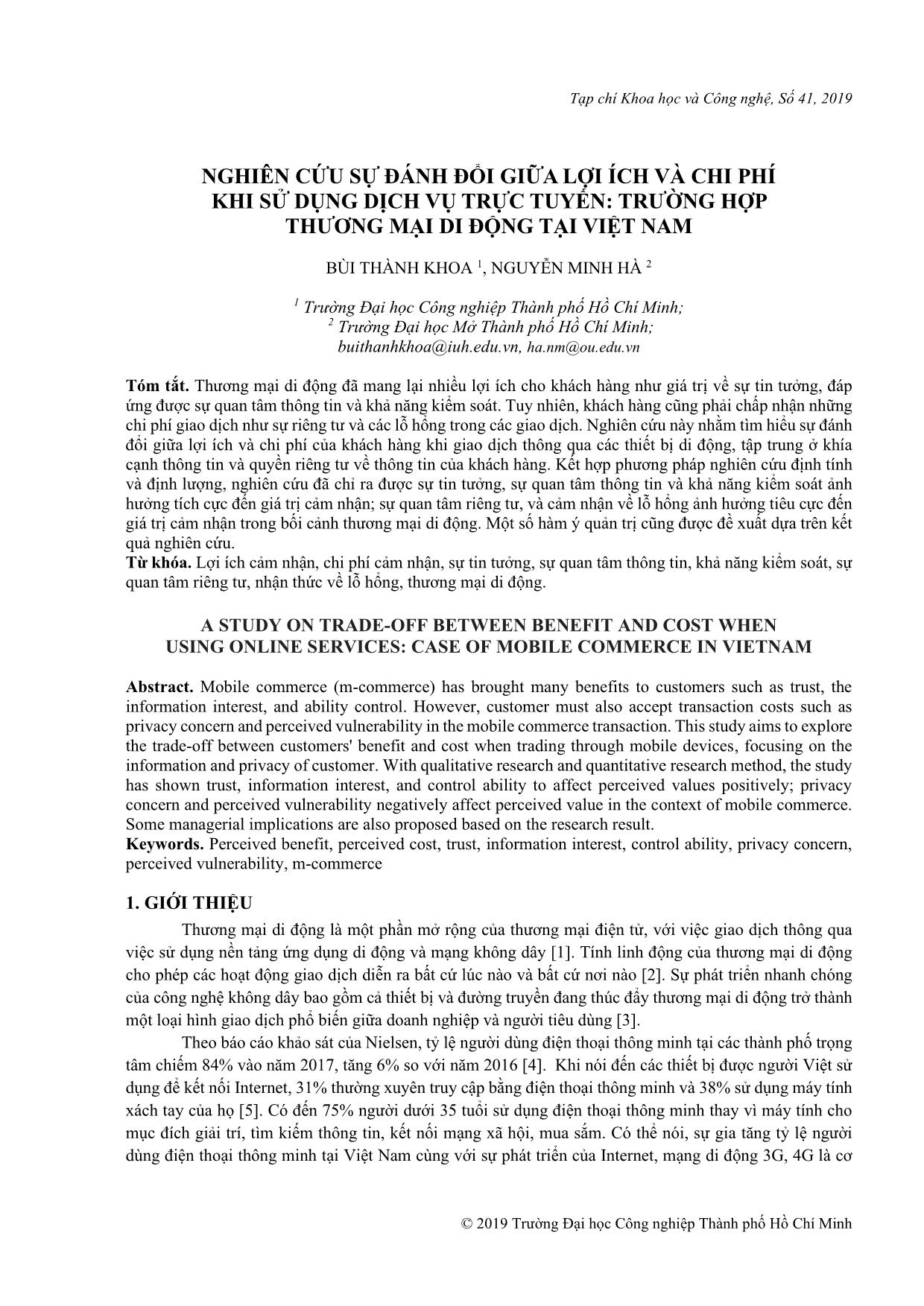
Trang 1
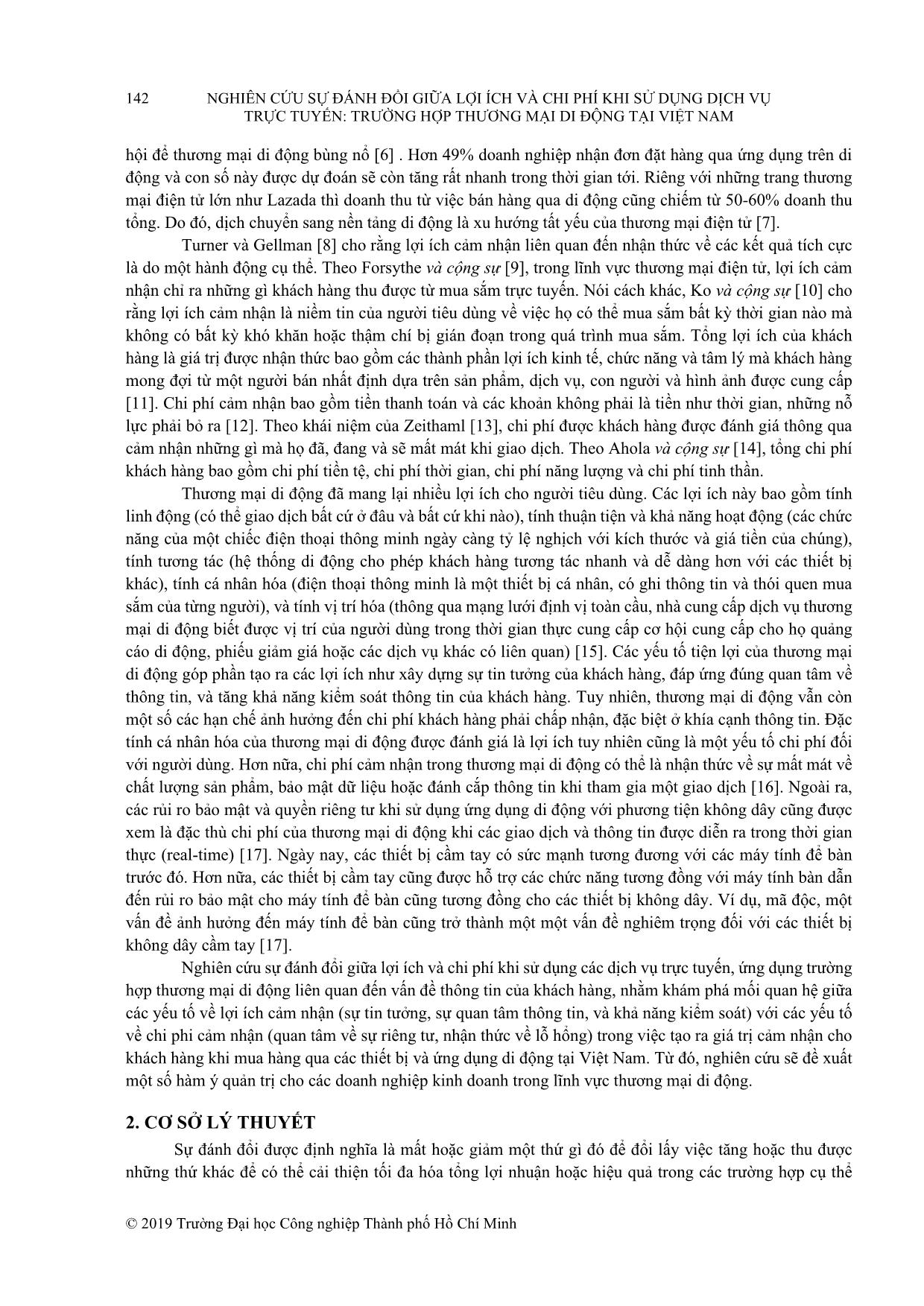
Trang 2
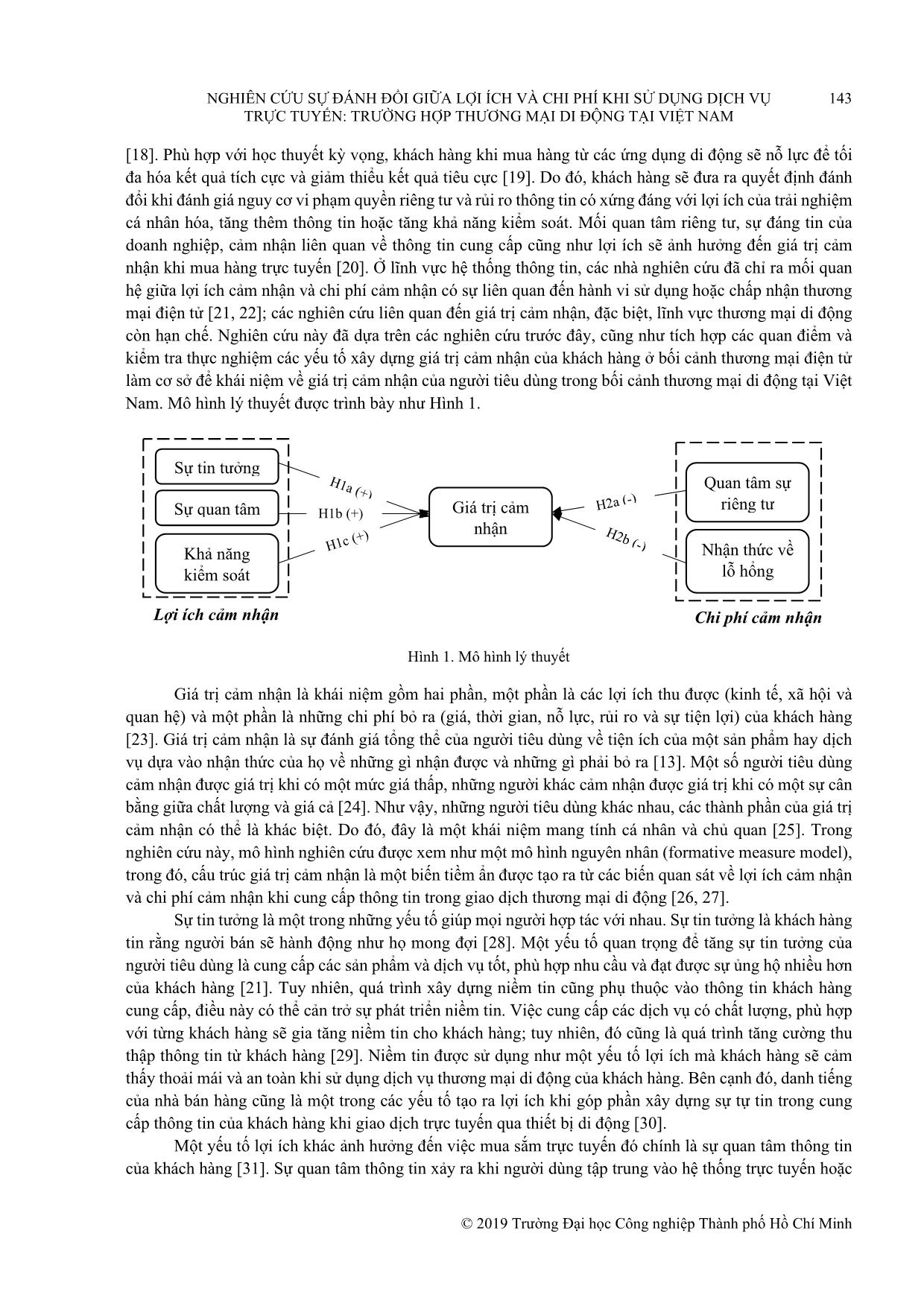
Trang 3
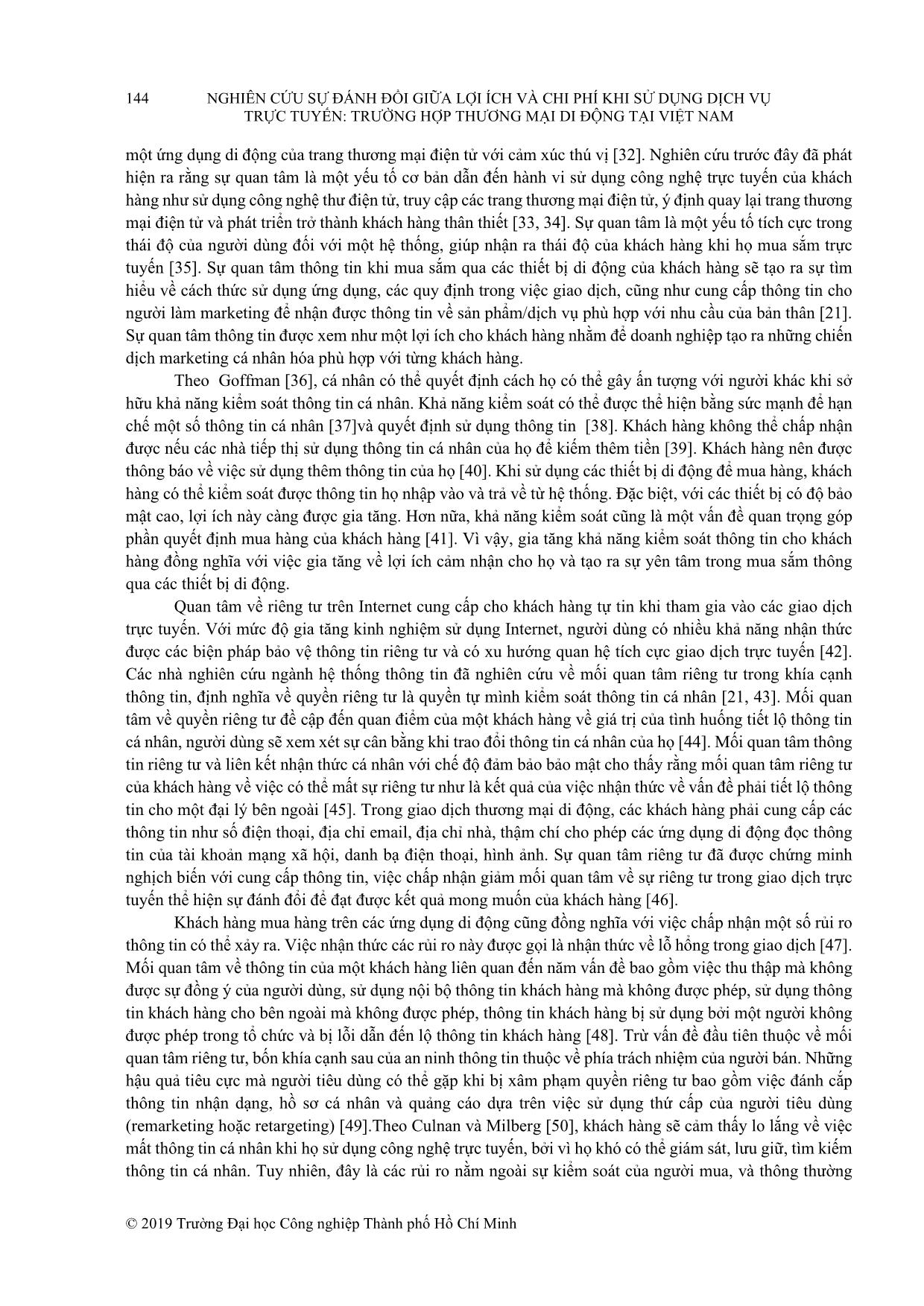
Trang 4
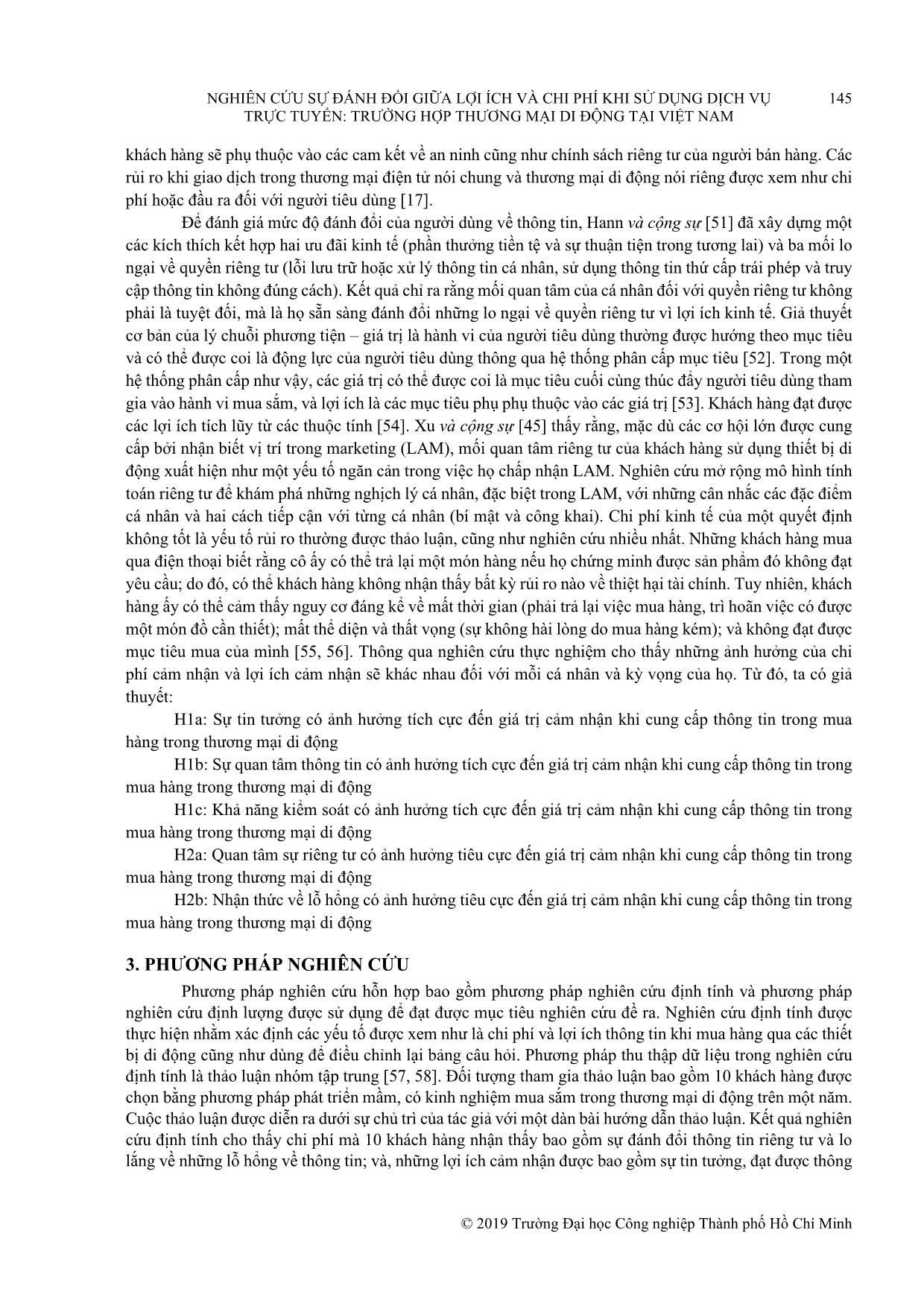
Trang 5
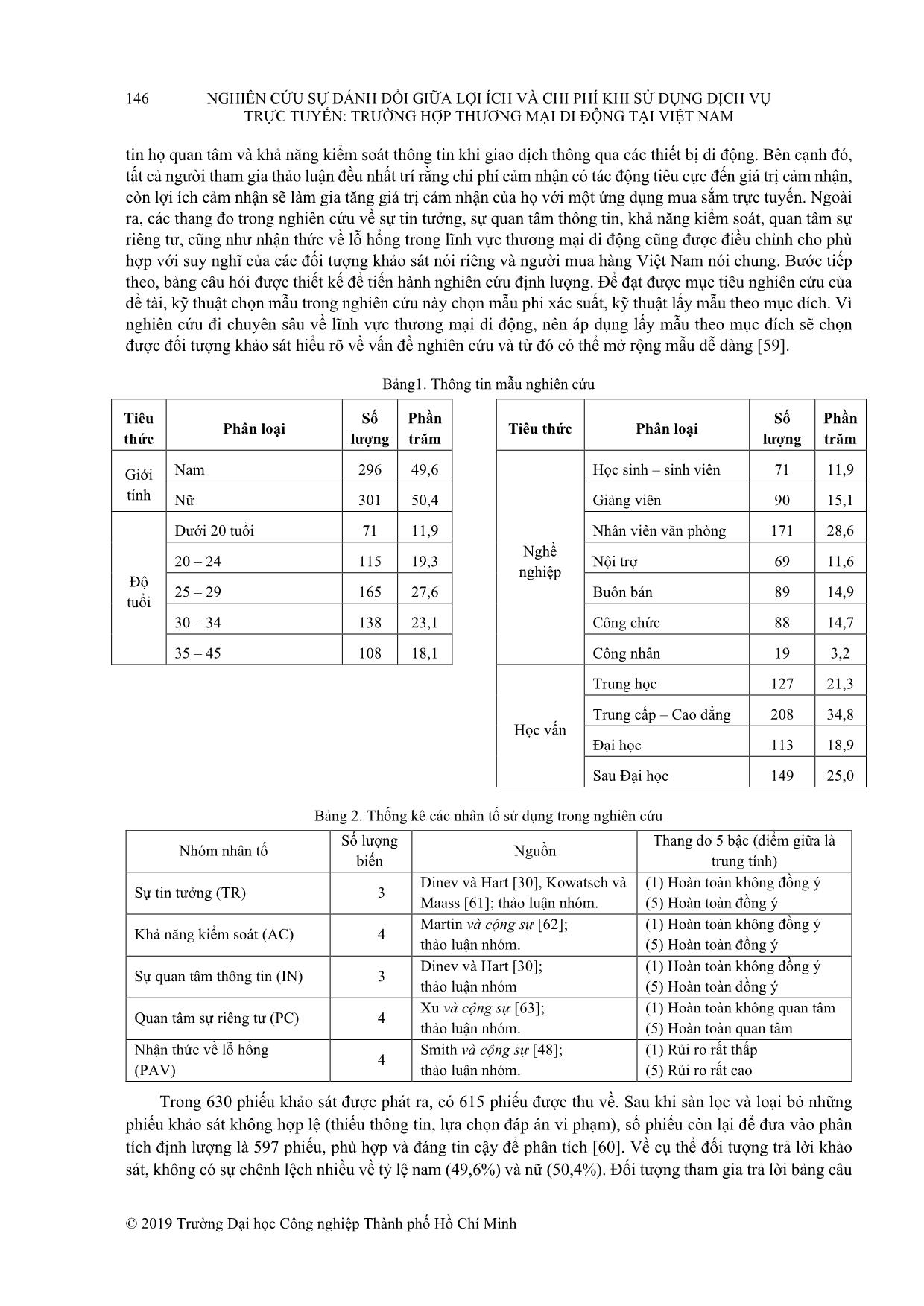
Trang 6
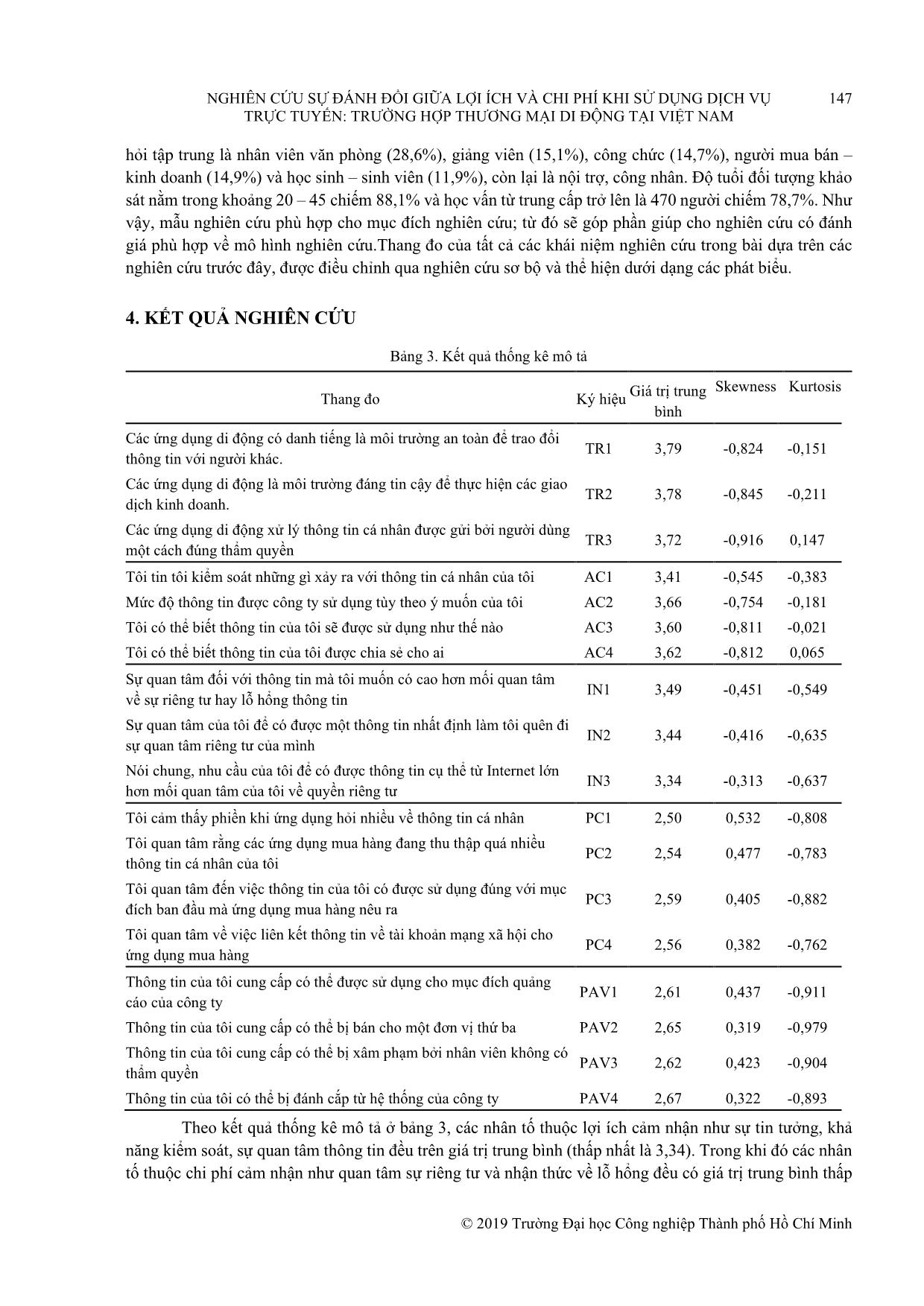
Trang 7
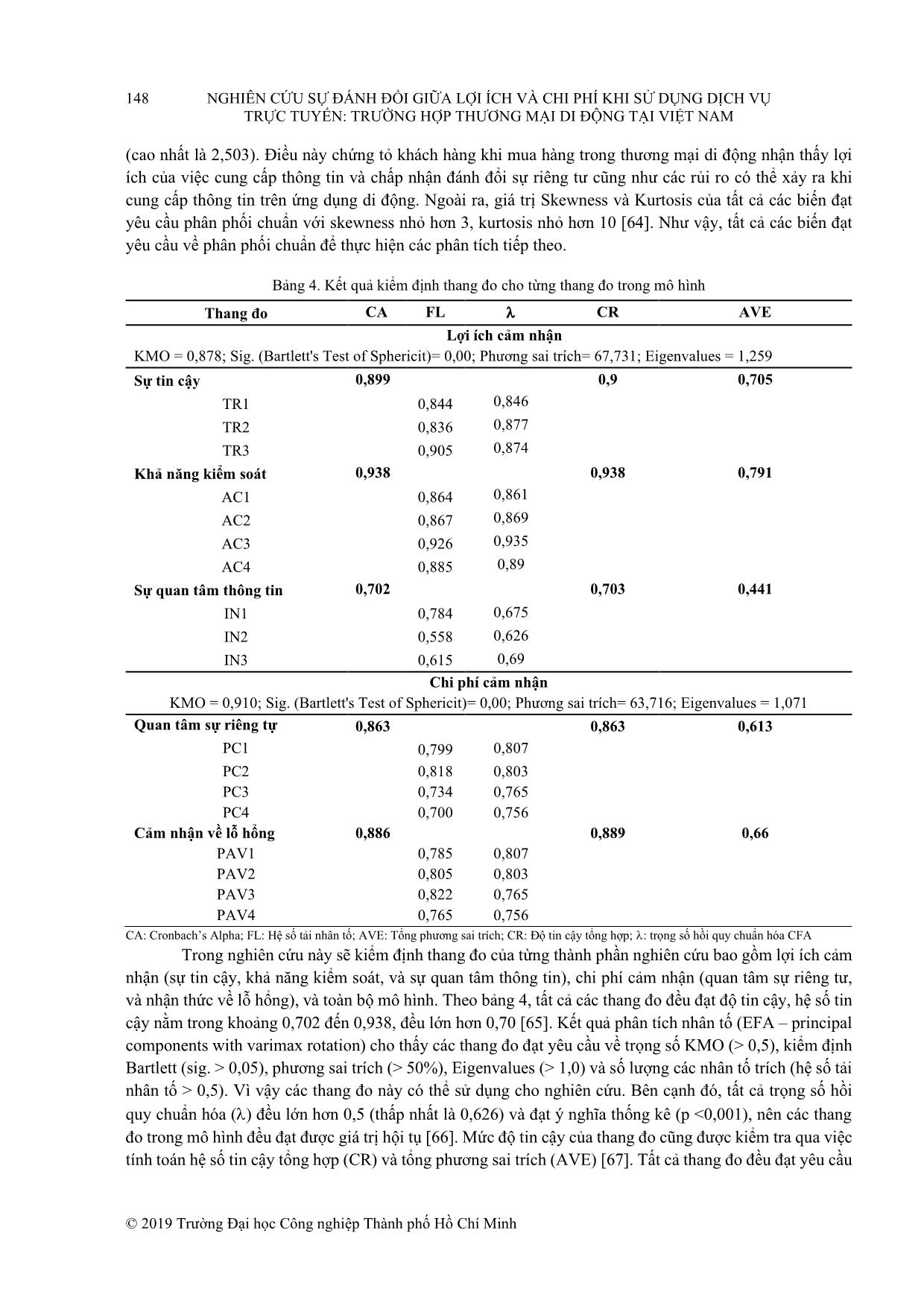
Trang 8
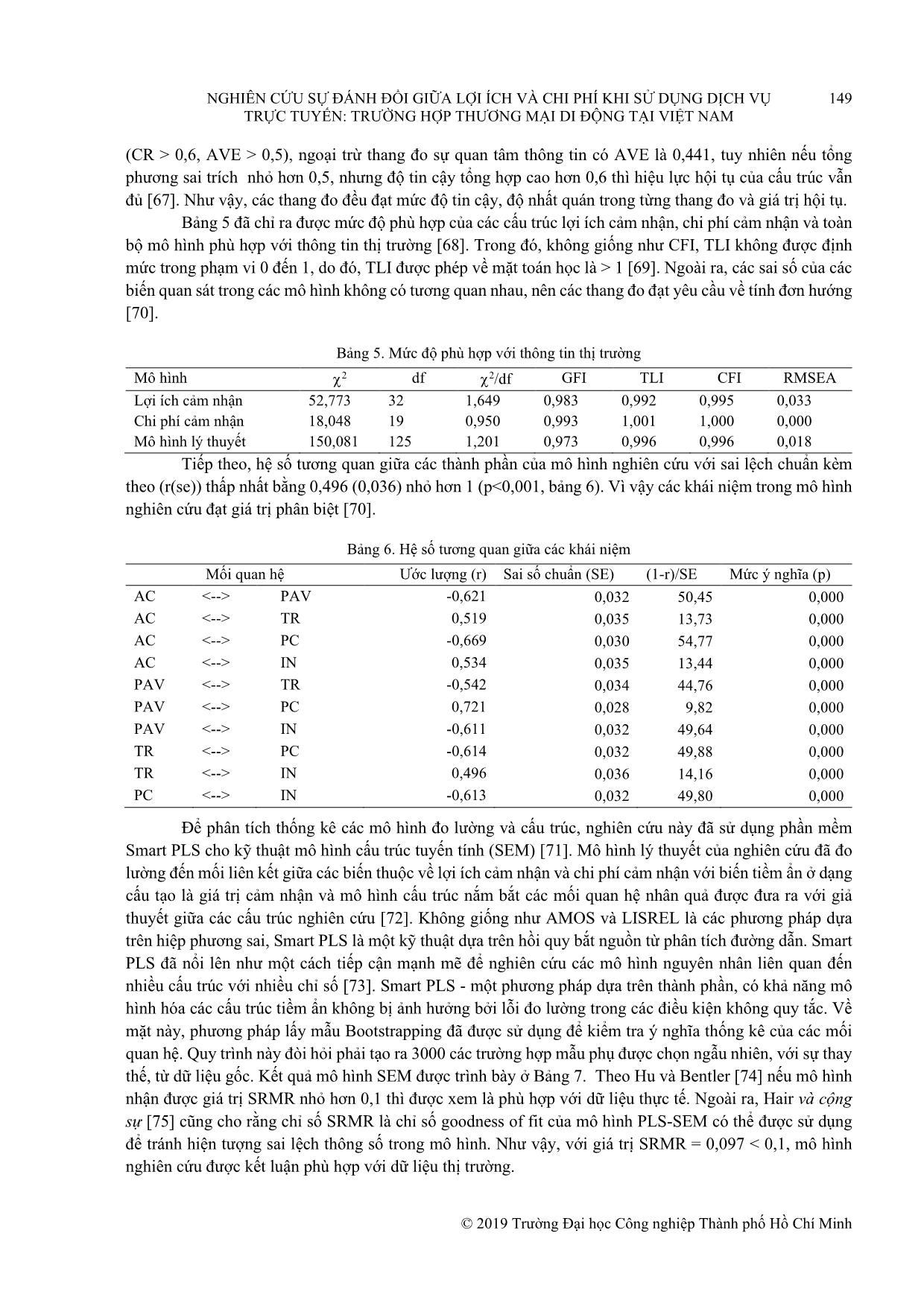
Trang 9
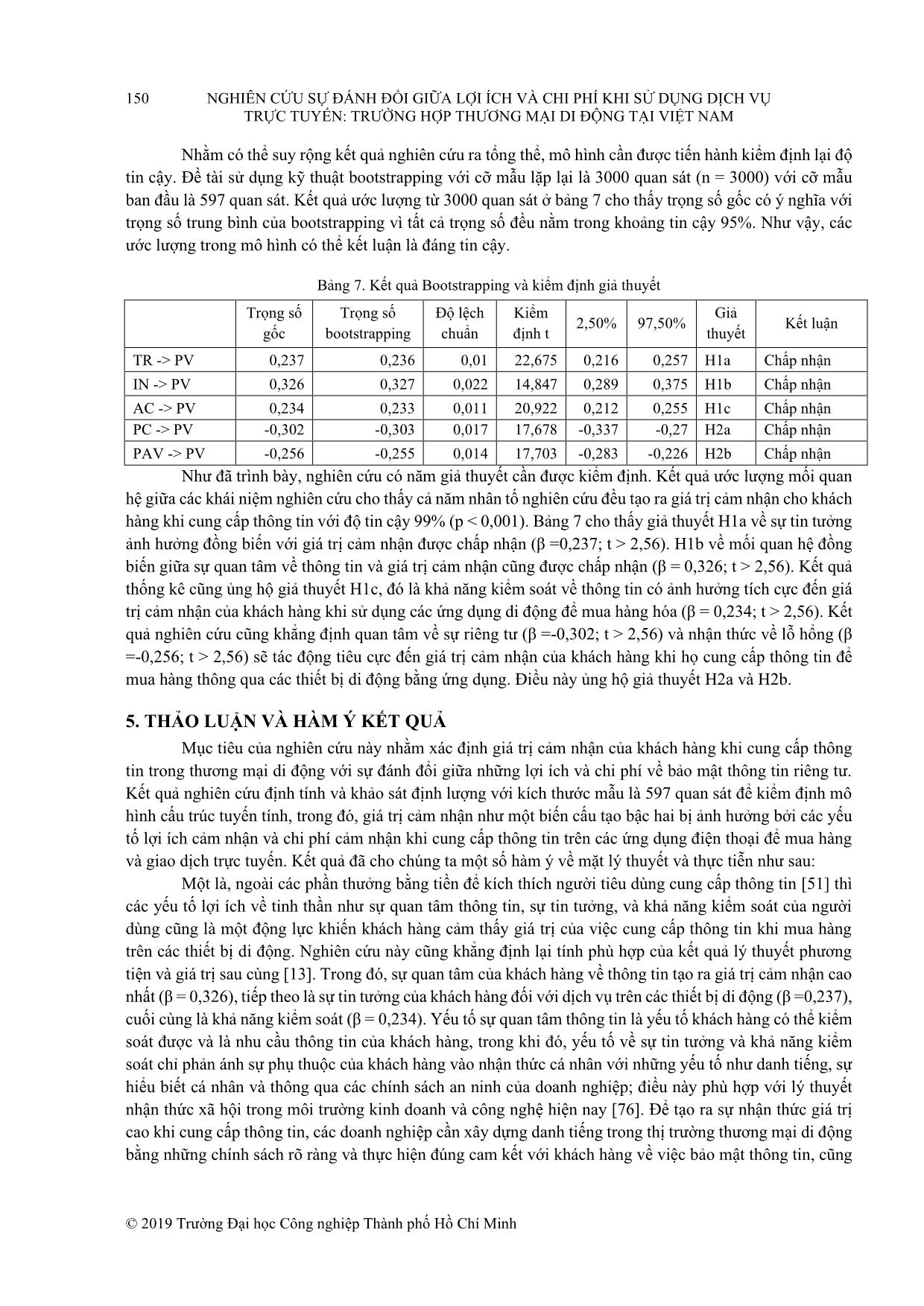
Trang 10
Tải về để xem bản đầy đủ
Tóm tắt nội dung tài liệu: Nghiên cứu sự đánh đổi giữa lợi ích và chi phí khi sử dụng dịch vụ trực tuyến: Trường hợp thương mại di động tại Việt Nam
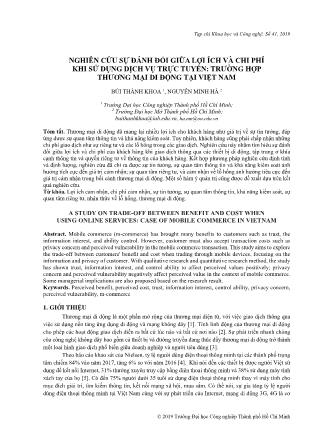
h nghiệp. 6. HẠN CHẾ VÀ HƯỚNG NGHIÊN CỨU TIẾP THEO Tuy đã cố gắng thực hiện một cách khoa học và hoàn thiện nhất, nhưng nghiên cứu vẫn còn một số hạn chế. Thứ nhất, nghiên cứu chỉ mới thực nghiệm chung chung thương mại di động, mặc dù thương mại di động là một lĩnh vực tương đối rộng với nhiều loại mặt hàng và hình thức kinh doanh. Thứ hai, về phương pháp chọn mẫu, vì lý do thời gian và khung dữ liệu, nên tác giả chỉ có thể chọn mẫu phi xác suất có đánh giá, điều này làm giảm độ tin cậy của nghiên cứu. Thứ ba, nghiên cứu chỉ tập trung vào giá trị, lợi ích và chi phí thông tin trong giao dịch thương mại di động. Những nghiên cứu tiếp theo có thể khắc phục một số hạn chế của nghiên cứu này bằng cách tập trung vào một doanh nghiệp cụ thể hay hàng hóa cụ thể trong nghiên cứu. Bên cạnh đó, có thể xây dựng khung chọn mẫu và chọn mẫu để điều tra theo phương pháp xác suất để tạo độ tin cậy cao hơn cho nghiên cứu. Một số biến nghiên cứu có thể đươc tăng cường để có thể tạo ra nghiên cứu mở rộng, đặc biệt là các biến nghiên cứu về lợi ích cảm nhận, chi phí cảm nhận ở các khía cạnh khác ngoài khía cạnh thông tin trong giao dịch thương mại điện tử. TÀI LIỆU THAM KHẢO [1] M. S. Chhonker, D. Verma và A. K. Kar, Review of technology adoption frameworks in mobile commerce, Procedia computer science, vol. 122, pp. 888-895, 2017. [2] S. Hillman và C. Neustaedter, Trust and mobile commerce in North America, Computers in Human Behavior, vol. 70, pp. 10-21, 2017. [3] W. T. Rupp và A. D. Smith, Mobile commerce: New revenue machine or black hole?, Business Horizons, vol. 45, pp. 26-26, 2002. [4] Nielsen, Điện thoại thông minh tiếp tục trên đà phát triển ở cả khu vực thành thị và nông thôn, 2017. [5] Nielsen. Người Việt sử dụng hơn ba ngày làm việc để online mỗi tuần. Internet: https://www.nielsen.com/vn/vi/insights/2016/vietnam-cross-platform-2016.html, ngày truy cập: 24/06/2018 152 NGHIÊN CỨU SỰ ĐÁNH ĐỔI GIỮA LỢI ÍCH VÀ CHI PHÍ KHI SỬ DỤNG DỊCH VỤ TRỰC TUYẾN: TRƯỜNG HỢP THƯƠNG MẠI DI ĐỘNG TẠI VIỆT NAM © 2019 Trường Đại học Công nghiệp Thành phố Hồ Chí Minh [6] Cục Thương mại điện tử và kinh tế số, Sách trắng Thương mại điện tử Việt Nam 2018, www.idea.gov.vn, 2018. [7] VECITA, Báo cáo Thương mại điện tử Việt Nam 2017, Cục Thương mại điện tử và Công nghệ thông tin, Bộ Công Thương, 2017. [8] J. R. Turner và M. Gellman, Encyclopedia of Behavioral Medicine: Springer, 2013. [9] S. Forsythe, C. Liu, D. Shannon và L. C. Gardner, Development of a scale to measure the perceived benefits and risks of online shopping, Journal of interactive marketing, vol. 20, pp. 55-75, 2006. [10] H. Ko, J. Jung, J. Kim và S. W. Shim, Cross-cultural differences in perceived risk of online shopping, Journal of Interactive Advertising, vol. 4, pp. 20-29, 2004. [11] P. Kotler và K. L. Keller, Marketing management vol. 15e: Pearson, 2016. [12] R. N. Bolton và K. N. Lemon, A dynamic model of customers' usage of services: Usage as an antecedent and consequence of satisfaction, Journal of marketing research, pp. 171-186, 1999. [13] V. A. Zeithaml, Consumer perceptions of price, quality, and value: a means-end model and synthesis of evidence, The Journal of marketing, pp. 2-22, 1988. [14] H. Ahola, H. Oinas-Kukkonen và T. Koivumaki, "Customer delivered value in a web-based supermarket," in System Sciences, 2000. Proceedings of the 33rd Annual Hawaii International Conference on, 2000, p. 10 pp. vol. 2. [15] E. Turban, J. Outland, D. King, J. K. Lee, T.-P. Liang và D. C. Turban, Electronic Commerce 2018: A Managerial and Social Networks Perspective: Springer, 2017. [16] R. Blaise, M. Halloran và M. Muchnick, Mobile commerce competitive advantage: A quantitative study of variables that predict m-commerce purchase intentions, Journal of Internet Commerce, vol. 17, pp. 96-114, 2018. [17] A. K. Ghosh và T. M. Swaminatha, Software security and privacy risks in mobile e-commerce, Communications of the ACM, vol. 44, pp. 51-57, 2001. [18] O. E. Oxford, Oxford English Dictionary: Oxford: Oxford University Press, 2009. [19] W. Van Eerde và H. Thierry, Vroom's expectancy models and work-related criteria: A meta-analysis, Journal of applied psychology, vol. 81, p. 575, 1996. [20] N. V. T. Trường, "A Study on the Typology of Internet Users Based on Privacy Concerns and Their Different Styles of Privacy Calculus Process," Doctor, Department of Business Administration, Soongsil University, Korea, 2012. [21] T. Dinev và P. Hart, "Privacy concerns and Internet use--a model of trade-off factors " in Academy of Management Proceedings, 2003, pp. D1-D6. [22] T. Tsu Wei, G. Marthandan, A. Yee-Loong Chong, K.-B. Ooi và S. Arumugam, What drives Malaysian m- commerce adoption? An empirical analysis, Industrial Management & Data Systems, vol. 109, pp. 370-388, 2009. [23] J. J. Cronin Jr, M. K. Brady và G. T. M. Hult, Assessing the effects of quality, value, and customer satisfaction on consumer behavioral intentions in service environments, Journal of retailing, vol. 76, pp. 193-218, 2000. [24] J. Sweeney và G. Soutar, Consumer perceived value: The development of a multiple item scale, Journal of retailing, vol. 77, pp. 203-220, 2001. NGHIÊN CỨU SỰ ĐÁNH ĐỔI GIỮA LỢI ÍCH VÀ CHI PHÍ KHI SỬ DỤNG DỊCH VỤ 153 TRỰC TUYẾN: TRƯỜNG HỢP THƯƠNG MẠI DI ĐỘNG TẠI VIỆT NAM © 2019 Trường Đại học Công nghiệp Thành phố Hồ Chí Minh [25] A. Parasuraman, L. L. Berry và V. A. Zeithaml, Understanding customer expectations of service, MIT Sloan Management Review, vol. 32, p. 39, 1991. [26] C.-H. Lin, P. J. Sher và H.-Y. Shih, Past progress and future directions in conceptualizing customer perceived value, International Journal of Service Industry Management, vol. 16, pp. 318-336, 2005. [27] J. Carlos Fandos Roig, J. Sanchez Garcia, M. Angel Moliner Tena và J. Llorens Monzonis, Customer perceived value in banking services, International Journal of Bank Marketing, vol. 24, pp. 266-283, 2006. [28] L. Ang, C. Dubelaar và B.-C. Lee, To trust or not to trust? A model of internet trust from the customer's point of view, BLED 2001 Proceedings, p. 43, 2001. [29] R. J. Bies, Privacy and procedural justice in organizations, Social Justice Research, vol. 6, pp. 69-86, 1993. [30] T. Dinev và P. Hart, An extended privacy calculus model for e-commerce transactions, Information systems research, vol. 17, pp. 61-80, 2006. [31] H. Van der Heijden, T. Verhagen và M. Creemers, Understanding online purchase intentions: contributions from technology and trust perspectives, European journal of information systems, vol. 12, pp. 41-48, 2003. [32] S. Pace, A grounded theory of the flow experiences of Web users, International journal of human-computer studies, vol. 60, pp. 327-363, 2004. [33] S. L. Jarvenpaa và P. A. Todd, Is there a future for retailing on the Internet, Electronic marketing and the consumer, vol. 1, pp. 139-154, 1997. [34] T. P. Novak, D. L. Hoffman và Y.-F. Yung, Measuring the customer experience in online environments: A structural modeling approach, Marketing science, vol. 19, pp. 22-42, 2000. [35] T. L. Childers, C. L. Carr, J. Peck và S. Carson, Hedonic and utilitarian motivations for online retail shopping behavior, Journal of retailing, vol. 77, pp. 511-535, 2001. [36] E. Goffman, Stigma: Notes on the management of spoiled identity: Simon and Schuster, 2009. [37] V. J. Derlega và A. L. Chaikin, Privacy and self‐disclosure in social relationships, Journal of Social Issues, vol. 33, pp. 102-115, 1977. [38] E. F. Stone và D. L. Stone, Privacy in organizations: Theoretical issues, research findings, and protection mechanisms, Research in personnel and human resources management, vol. 8, pp. 349-411, 1990. [39] G. J. Nowak và J. Phelps, Direct marketing and the use of individual-level consumer information: Determining how and when “privacy” matters, Journal of Interactive Marketing, vol. 11, pp. 94-108, 1997. [40] P. Wang và L. A. Petrison, Direct marketing activities and personal privacy. A consumer survey, Journal of Direct Marketing, vol. 7, pp. 7-19, 1993. [41] J. Phelps, G. Nowak và E. Ferrell, Privacy concerns and consumer willingness to provide personal information, Journal of Public Policy & Marketing, vol. 19, pp. 27-41, 2000. [42] A. Gurung, X. Luo và M. Raja, An empirical investigation on customer’s privacy perceptions, trust and security awareness in E-commerce environment, Journal of Information Privacy and Security, vol. 4, pp. 42- 60, 2008. [43] R. N. Stone và K. Grønhaug, Perceived risk: Further considerations for the marketing discipline, European Journal of marketing, vol. 27, pp. 39-50, 1993. [44] N. K. Malhotra, S. S. Kim và J. Agarwal, Internet users' information privacy concerns (IUIPC): The construct, the scale, and a causal model, Information systems research, vol. 15, pp. 336-355, 2004. 154 NGHIÊN CỨU SỰ ĐÁNH ĐỔI GIỮA LỢI ÍCH VÀ CHI PHÍ KHI SỬ DỤNG DỊCH VỤ TRỰC TUYẾN: TRƯỜNG HỢP THƯƠNG MẠI DI ĐỘNG TẠI VIỆT NAM © 2019 Trường Đại học Công nghiệp Thành phố Hồ Chí Minh [45] H. Xu, X. R. Luo, J. M. Carroll và M. B. Rosson, The personalization privacy paradox: An exploratory study of decision making process for location-aware marketing, Decision support systems, vol. 51, pp. 42-52, 2011. [46] B. T. Khoa, Nghiên cứu nhận thức bảo vệ thông tin riêng tư của người mua hàng trực tuyến tại TP.HCM, Tạp chí Khoa học và Công nghệ, vol. 2, pp. 66-76, 2017. [47] C. D. Raab, The distribution of privacy risks: Who needs protection?, The information society, vol. 14, pp. 263-274, 1998. [48] H. J. Smith, S. J. Milberg và S. J. Burke, Information privacy: measuring individuals' concerns about organizational practices, MIS quarterly, pp. 167-196, 1996. [49] M. E. Budnitz, Privacy protection for consumer transactions in electronic commerce: why self-regulation is inadequate, SCL Rev., vol. 49, p. 847, 1997. [50] M. J. Culnan và S. Milberg, The second exchange: Managing customer information in marketing relationships, 1998. [51] I.-H. Hann, K.-L. Hui, T. Lee và I. Png, Online information privacy: Measuring the cost-benefit trade-off, ICIS 2002 proceedings, p. 1, 2002. [52] J. Gutman, Means–end chains as goal hierarchies, Psychology & marketing, vol. 14, pp. 545-560, 1997. [53] C. M. Chiu, E. T. Wang, Y. H. Fang và H. Y. Huang, Understanding customers' repeat purchase intentions in B2C e‐commerce: the roles of utilitarian value, hedonic value and perceived risk, Information Systems Journal, vol. 24, pp. 85-114, 2014. [54] J. Gutman, A means-end chain model based on consumer categorization processes, The Journal of Marketing, pp. 60-72, 1982. [55] D. Cox và S. Rich, Perceived risk and consumer decision-making: The case of telephone shopping, Journal of marketing research, pp. 32-39, 1964. [56] L. F. Cunningham, J. Gerlach và M. D. Harper, Assessing perceived risk of consumers in Internet airline reservations services, Journal of Air Transportation, vol. 9, 2004. [57] F. Rabiee, Focus-group interview and data analysis, Proceedings of the nutrition society, vol. 63, pp. 655- 660, 2004. [58] D. Silverman, Qualitative research: Sage, 2016. [59] W. L. Neuman, Social research methods: Qualitative and quantitative approaches: Pearson education, 2013. [60] J. F. Hair, R. E. Anderson, B. J. Babin và W. C. Black, Multivariate data analysis: A global perspective vol. 7: Pearson Upper Saddle River, NJ, 2010. [61] T. Kowatsch và W. Maass, "Critical privacy factors of internet of things services: An empirical investigation with domain experts," in Knowledge and Technologies in Innovative Information Systems: Springer, 2012, pp. 200-211. [62] K. D. Martin, A. Borah và R. W. Palmatier, Data privacy: Effects on customer and firm performance, Journal of Marketing, vol. 81, pp. 36-58, 2017. [63] H. Xu, T. Dinev, H. J. Smith và P. Hart, Examining the formation of individual's privacy concerns: Toward an integrative view, ICIS 2008 proceedings, p. 6, 2008. [64] R. B. Kline, Principles and practice of structural equation modeling: Guilford publications, 2015. [65] J. C. Nunnally và I. Bernstein, The assessment of reliability, Psychometric theory, vol. 3, pp. 248-292, 1994. NGHIÊN CỨU SỰ ĐÁNH ĐỔI GIỮA LỢI ÍCH VÀ CHI PHÍ KHI SỬ DỤNG DỊCH VỤ 155 TRỰC TUYẾN: TRƯỜNG HỢP THƯƠNG MẠI DI ĐỘNG TẠI VIỆT NAM © 2019 Trường Đại học Công nghiệp Thành phố Hồ Chí Minh [66] J. C. Anderson và D. W. Gerbing, Structural equation modeling in practice: A review and recommended two- step approach, Psychological bulletin, vol. 103, p. 411, 1988. [67] C. Fornell và D. F. Larcker, Evaluating structural equation models with unobservable variables and measurement error, Journal of marketing research, pp. 39-50, 1981. [68] P. M. Bentler và D. G. Bonett, Significance tests and goodness of fit in the analysis of covariance structures, Psychological bulletin, vol. 88, p. 588, 1980. [69] H. W. Marsh, J. R. Balla và K.-T. Hau, An evaluation of incremental fit indices: A clarification of mathematical and empirical properties, Advanced structural equation modeling: Issues and techniques, pp. 315-353, 1996. [70] J.-B. E. Steenkamp và H. C. Van Trijp, The use of LISREL in validating marketing constructs, International Journal of Research in marketing, vol. 8, pp. 283-299, 1991. [71] C. Ringle, S. Wende và A. Will, SmartPLS version 2.0 M2, Hamburg, Germany: Institute for Operations Management and Organization at the University of Hamburg, 2005. [72] W. W. Chin và P. R. Newsted, Structural equation modeling analysis with small samples using partial least squares, Statistical strategies for small sample research, vol. 1, pp. 307-341, 1999. [73] R. Chinomona và J. Surujlal, The influence of student internship work experience on their self-improvement and professionalism in Sport Management: sport management, African Journal for Physical Health Education, Recreation and Dance, vol. 18, pp. 885-899, 2012. [74] L. t. Hu và P. M. Bentler, Cutoff criteria for fit indexes in covariance structure analysis: Conventional criteria versus new alternatives, Structural equation modeling: a multidisciplinary journal, vol. 6, pp. 1-55, 1999. [75] J. F. Hair, J. Henseler, T. K. Dijkstra và M. Sarstedt, Common beliefs and reality about partial least squares: comments on Rönkkö and Evermann, 2014. [76] C.-M. Chiu, M.-H. Hsu và E. T. Wang, Understanding knowledge sharing in virtual communities: An integration of social capital and social cognitive theories, Decision support systems, vol. 42, pp. 1872-1888, 2006. [77] M. S. Featherman và P. A. Pavlou, Predicting e-services adoption: a perceived risk facets perspective, International journal of human-computer studies, vol. 59, pp. 451-474, 2003. Ngày nhận bài: 02/02/2019 Ngày chấp nhận đăng: 20/02/2019
File đính kèm:
 nghien_cuu_su_danh_doi_giua_loi_ich_va_chi_phi_khi_su_dung_d.pdf
nghien_cuu_su_danh_doi_giua_loi_ich_va_chi_phi_khi_su_dung_d.pdf

